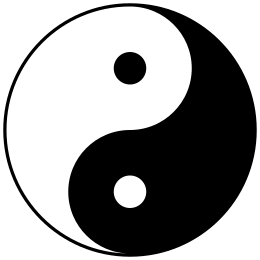If you have ever done yoga, or gone for acupuncture, or read anything about Chinese medicine or healing, you will have noticed a similarity between the discussion on symmetry in the previous posts and the Chinese philosophy of life (and the natural world, and human behaviour in general) as expressed in yin and yang. This philosophy forms the basis for understanding of the benefits to humanity of complementarity.
That is, rather than seeing different forces or elements of life as being in opposition, it is more helpful to view them as complementing each other – and that each element has value in itself. (I gave a small taster of this in the Chapter on Cause, Effect and Nurture, when I highlighted the benefit/value of darkness).
Yin and yang proposes that everything in the natural world is interconnected, interrelated and interdependent (i.e. Systems Theory as I described it in Section Three). Yin and yang is manifest in symmetry as I referred to above, e.g. day-night, winter-summer, north-south, male-female, fire-water, bigger-smaller and order-disorder (which I will be referring to again in the Chapter on Energy – Sub-Chapter on Entropy).
Relevant to this website, in respect of healing and medicine, Yin and Yang implies balance in the physical, mental, emotional and spiritual spheres.
This symmetry is not only valued in healing but is desirable for healthy living in general. Because an entity cannot exist without its opposite, yin and yang also implies the kind of thinking that the whole is greater than the sum of the parts, which we have also come across before.
Below is the perfectly symmetrical yin-yang symbol – which, when I look at it for a few moments, has a kind of a hypnotic effect on me.

